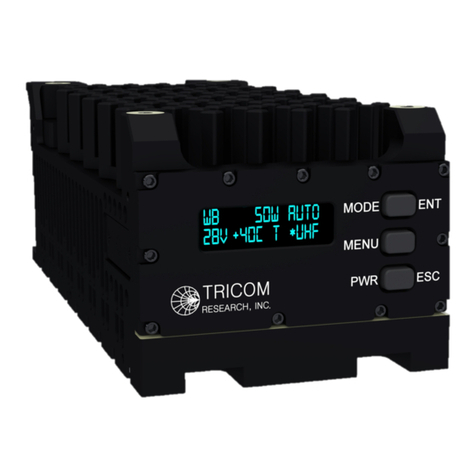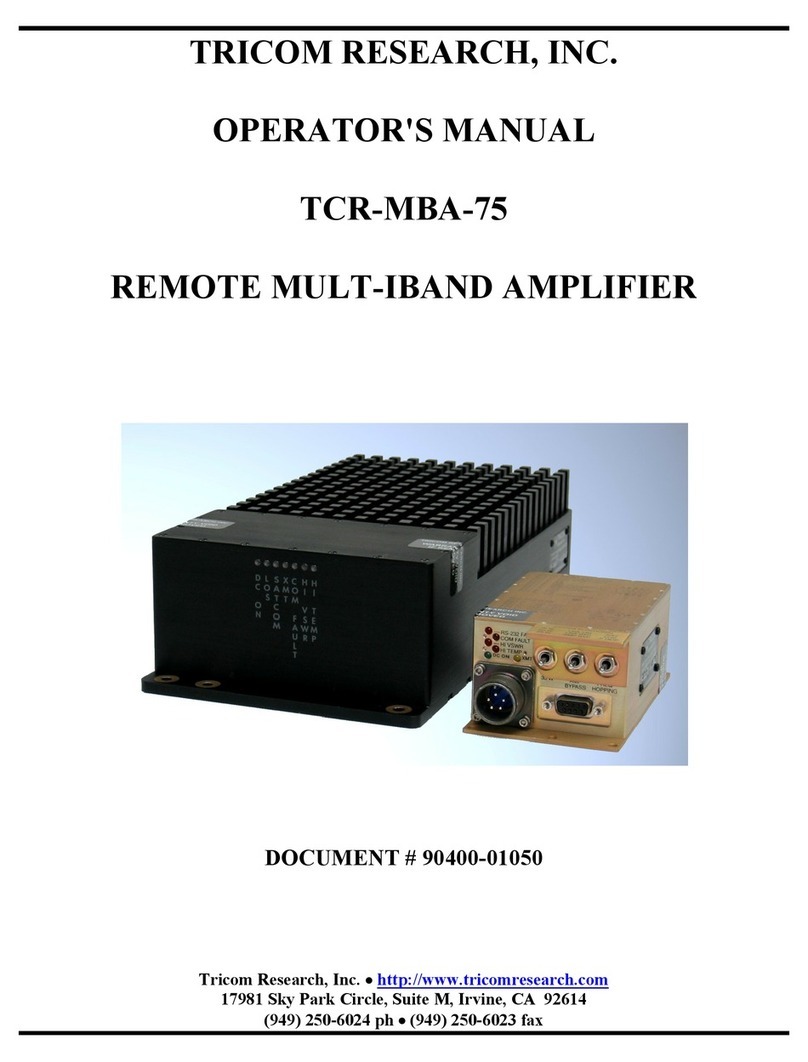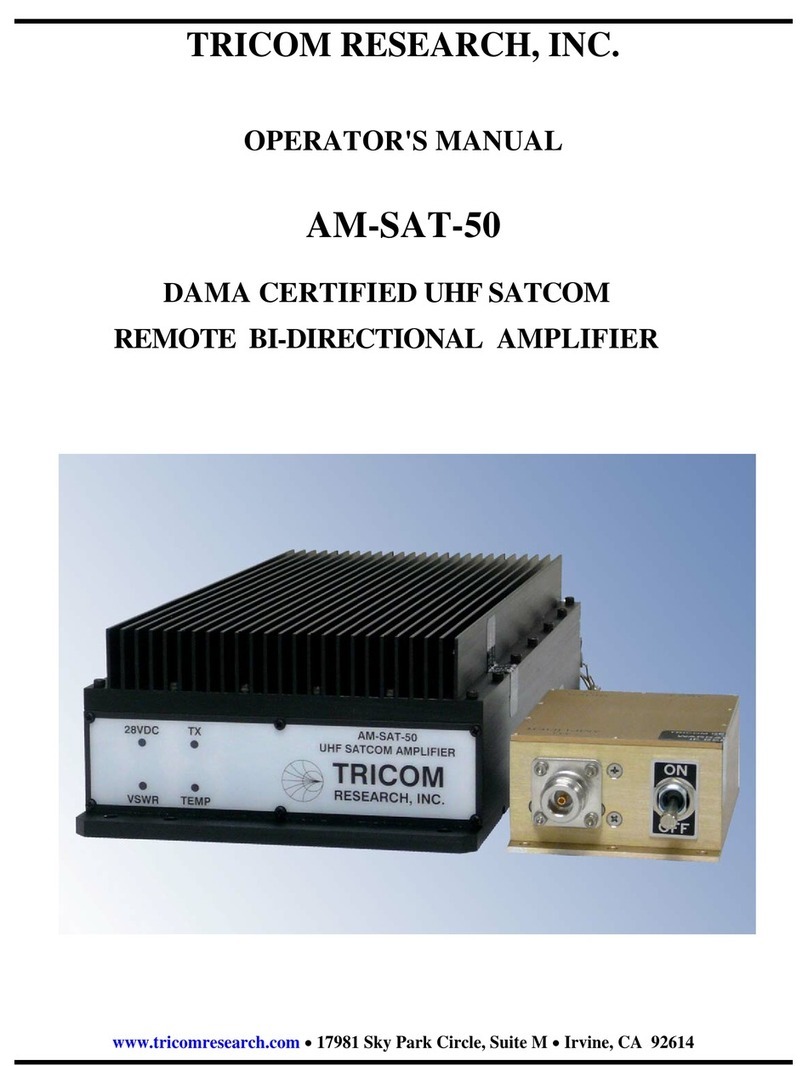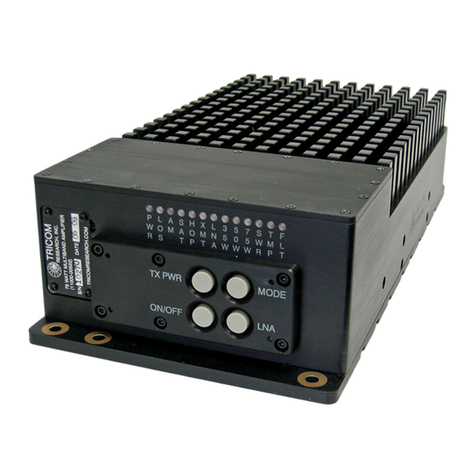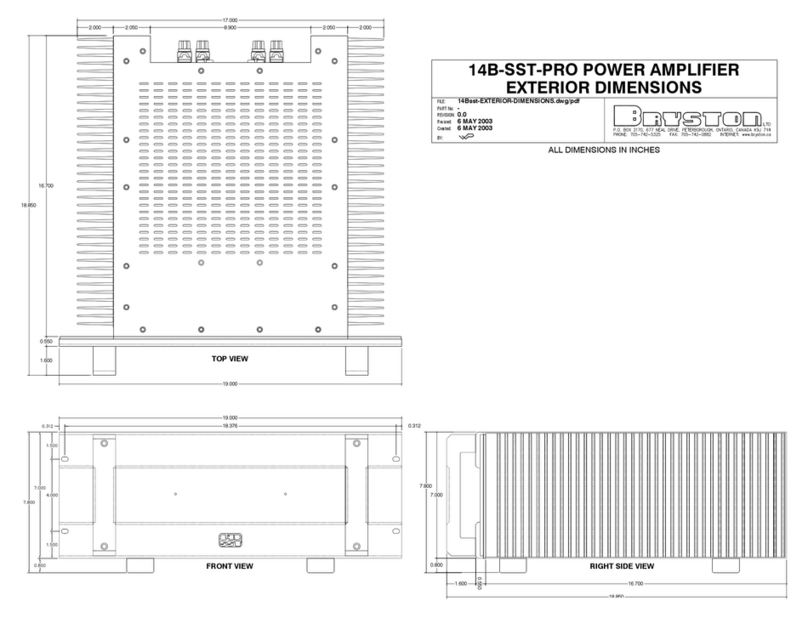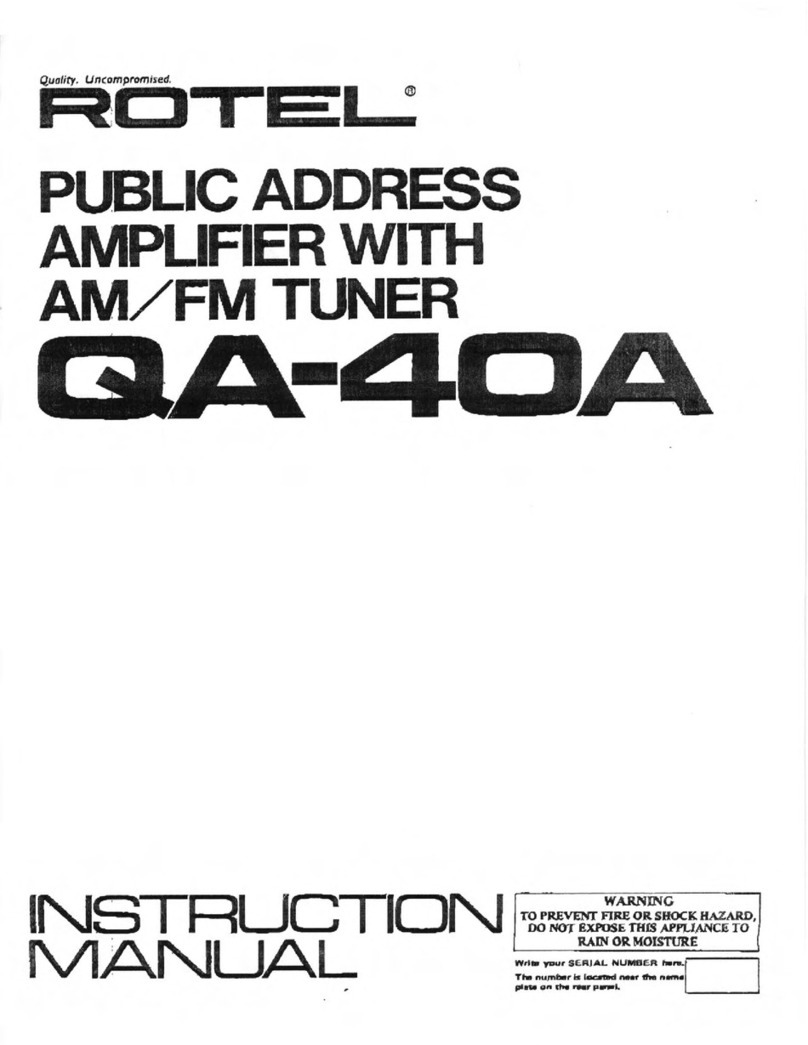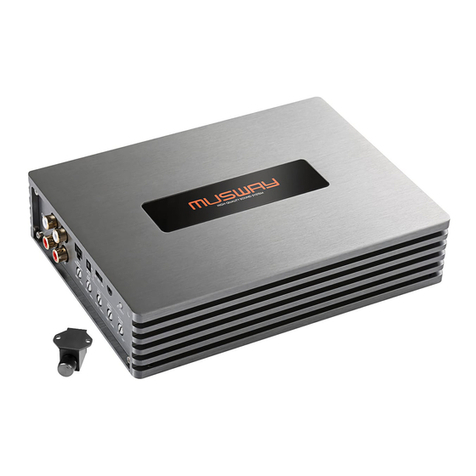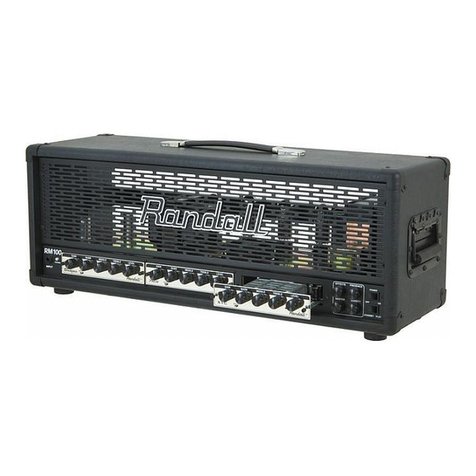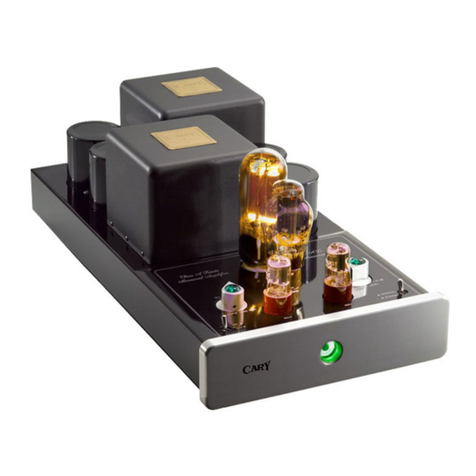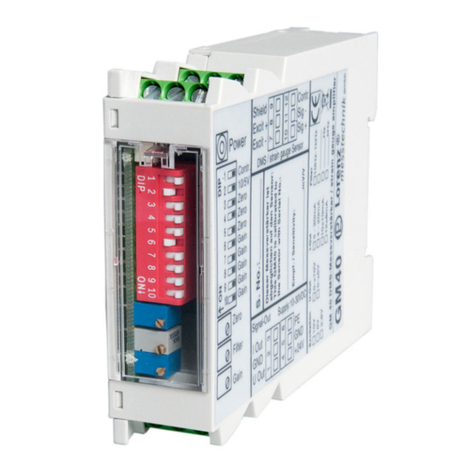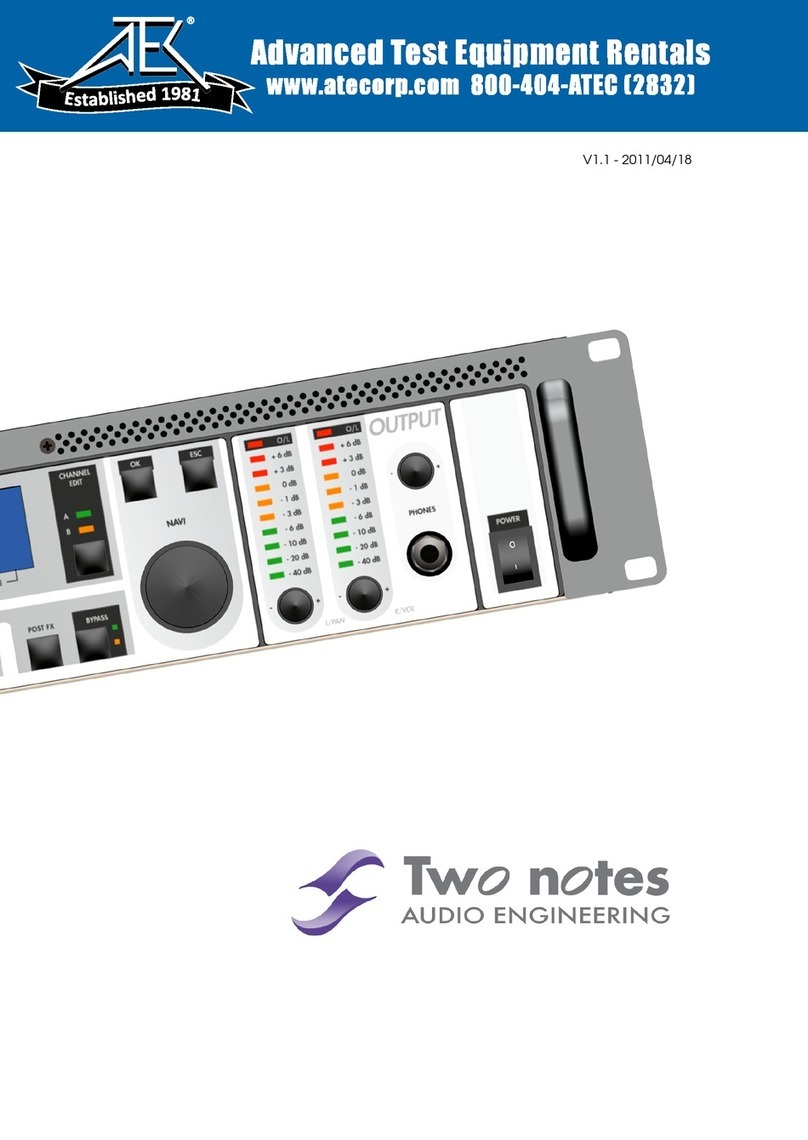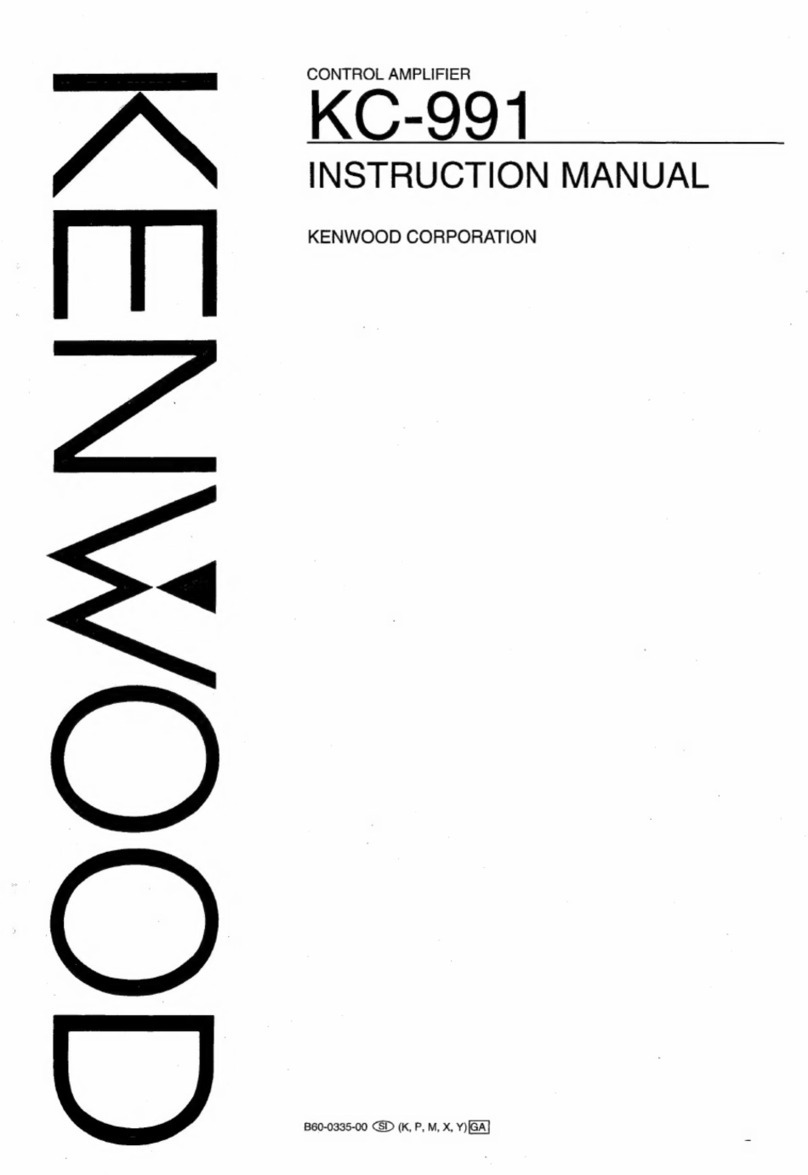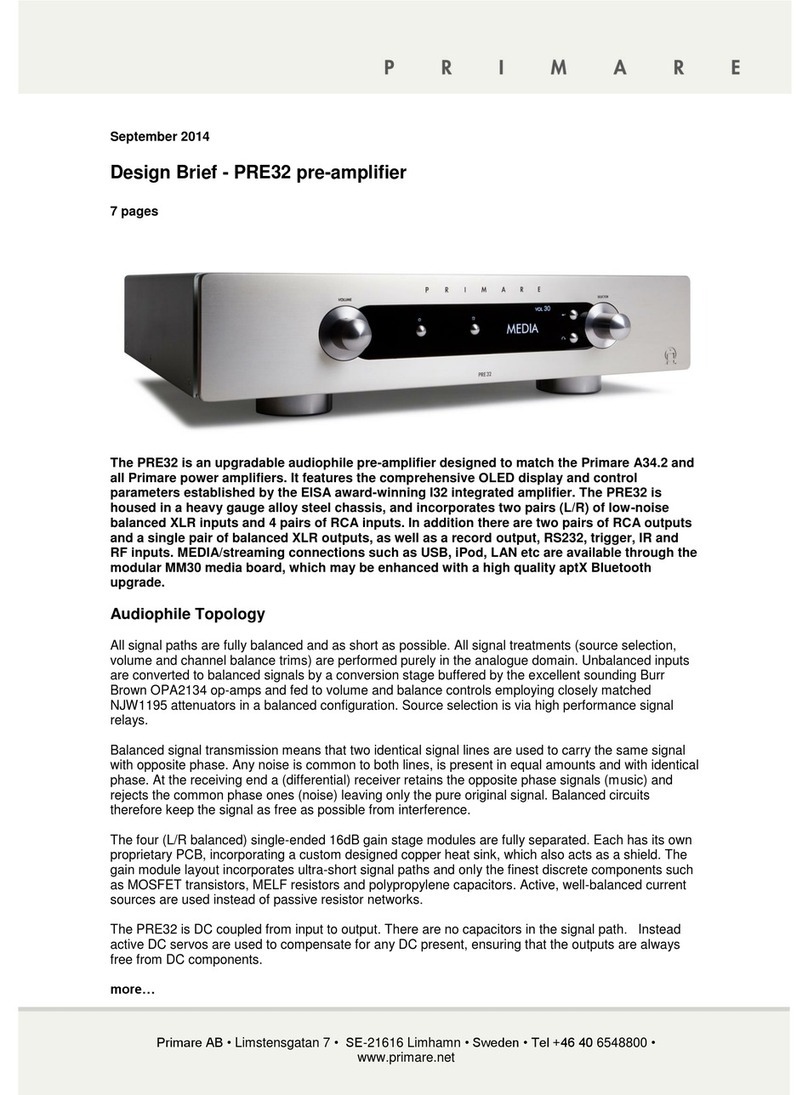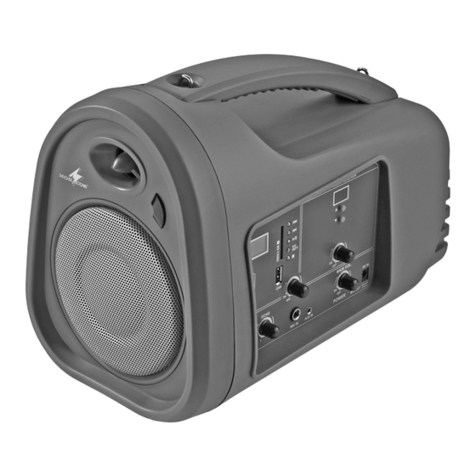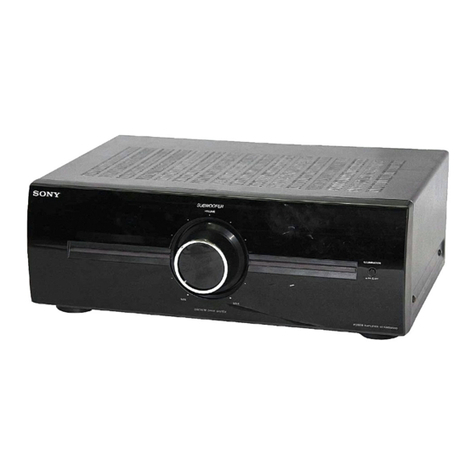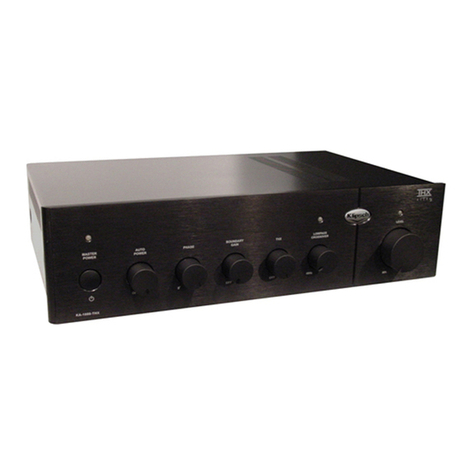TriCom TCR-U/L-25 User manual

OPERATOR'S MANUAL
TCR-U/L-25 - UHF/L-BAND
RF AMPLIFIER
DOCUMENT # 90400-01178
Tricom Research, Inc. http://www.tricomresearch.com
17791 Sky Park Circle, Suite J, Irvine, CA 92614
Ph: (949) 250-6024 fax: (949) 250-6023

TCR-U/L-25 OPERATOR’S MANUAL
i
Revision History - Document 90400-01178
Revision Description Date
P1 Preliminar
y
Release 18 Oct 2013
P2 Updated size and power output specifications, updated
outline fi
g
ures and drawin
g
s
18 Jun 2014
P3 Updatin
g
for automatic mode detection 10 Nov 2014
P4 Reformatted Fi
g
ures 3-1 and 3-6 11 Dec 2014
A Updated for current production Release 6 Mar 2015
B Reconcile with data sheets 2 Apr 2018

TCR-U/L-25 OPERATOR’S MANUAL
ii
TABLE OF CONTENTS
1.0 INTRODUCTION
1.1 General Information .......................................................................................1
1.2 Abbreviations and Glossary ...........................................................................2
1.3 Equipment Description ..................................................................................3-6
1.4 Features ..........................................................................................................6
1.5 TCR-U/L-25 System ......................................................................................6
1.5.1 Amplifier Components...................................................................................6
1.5.2 Power Cable ...................................................................................................7
1.6 Specifications .................................................................................................7-8
2.0 OPERATION
2.1 General Information .......................................................................................9
2.2 Controls, Indicators, and Connectors .............................................................9-10
2.3 Operation........................................................................................................11
2.3.1 General Information .......................................................................................11
2.3.2 Equipment Set-up...........................................................................................11
2.3.3 Operating Procedures .....................................................................................11
2.3.3.1 Push Button Switch Operation .......................................................................11-12
2.3.3.2 LNA Operation Precautions ...........................................................................12
2.3.3.3 Remote Control Operation .............................................................................12
2.3.3.4 Out of Band Operation ...................................................................................12
2.3.3.5 Bypass Operation ...........................................................................................12
2.3.3.6 Troubleshooting .............................................................................................12
3.0 INSTALLATION
3.1 General Information .......................................................................................14
3.2 Preparation for Use ........................................................................................14
3.3 Mounting Provisions ......................................................................................14
3.4 DC Input Power .............................................................................................15
3.5 RF Interconnections .......................................................................................15
3.6 Remote Control Interface ...............................................................................19
3.7 Remote Control Command Set ......................................................................21

TCR-U/L-25 OPERATOR’S MANUAL
iii
LIST OF TABLES
Table 1-1 Nominal Performance Specifications ......................................................7
Table 1-2 Interconnect Characteristics .....................................................................8
Table 2-1 Mode Indicators .......................................................................................10
Table 2-2 Front Panel Controls ................................................................................10
Table 2-3 I/O Connectors .........................................................................................10
Table 2-4 Troubleshooting Guide ............................................................................11
Table 3-1 DC Input Power Connector Pinout ..........................................................17
Table 3-2 Auxiliary Connector Pinout .....................................................................19
Table 3-3 Remote Control Command Set ................................................................21
LIST OF FIGURES
Figure 1-1 TCR-U/L-25 .............................................................................................1
Figure 2-1 Amplifier Controls & Indicators ..............................................................9
Figure 2-2 Amplifier Connections .............................................................................9
Figure 3-1 TCR-U/L-25 Outline Drawing (1 of 2) ....................................................15
Figure 3-2 TCR-U/L-25 Outline Drawing (2 of 2) ....................................................16
Figure 3-3 Amplifier DC Input Connector ................................................................17
Figure 3-4 Military Vehicle DC Power Cable ...........................................................18
Figure 3-5 Auxiliary Connector Pinout .....................................................................19
Figure 3-6 USB Remote Control Cable .....................................................................20
Figure 3-7 RS-232 Remote Control Cable ................................................................20
Appendix A MS Windows Serial Comm Port Reassignment ......................................22
Note: The information contained herein is for reference only and does not constitute a warranty
of performance.

1
1.0 INTRODUCTION
1.1 GENERAL INFORMATION
This manual provides operating instructions for the TCR-U/L-25 Multiband Amplifiers
shown in Figure 1-1. The TCR-U/L-25 amplifier is designed to provide transmit and
receive gain for the following modes of operation:
SRW and ANW2 Wideband Networking Waveforms in the 225-450 MHz band
(UHF band)
SRW and ANW2 Wideband Networking Waveforms in the 1250-1390 MHz band
(L1 band)
SRW and ANW2 Wideband Networking Waveforms in the 1750-1850 MHz band
(L2 band)
L3 is for future use and consideration
Part number: 11000-00794
Figure 1-1 TCR-U/L-25

2
1.2 ABBREVIATIONS AND GLOSSARY
AGC Automatic gain control
ALC Automatic level control
AM Amplitude modulation
ANT Antenna
ANW2 Advanced Networking Wideband Waveform
BPS Bits per second
CT Cipher text
CW Continuous wave
COMSEC Communications security
dB Decibel
dBm Decibel referenced to 1 milliwatt (0 dBm = 1 mW)
FM Frequency modulation
Hz Hertz
IW Integrated Waveform
JITC Joint Interoperability Test Center (DISA)
kHz Kilohertz
LED Light emitting diode
LNA Low Noise Amplifier
LOS Line of sight
MHz Megahertz
mW Milliwatt
PT Plain text
PTT Push to Talk
RCV Receive
SATCOM Satellite Communications
SF Single Frequency
SRW Soldier Radio Waveform
UHF Ultra-high frequency
VDC Volts, direct current
VSWR Voltage standing wave ratio
W Watt
WB Wideband
XMT Transmit

3
1.3 EQUIPMENT DESCRIPTION
The TCR-U/L-25 is a bi-directional half duplex RF Power Amplifier that uses the same form
factor as the TCR-MBA-50 WB. It provides transmit amplification for 225-450 MHz, 1250-
1390 MHz and 1750-1850 MHz for ANW2 and SRW Wideband Networking operation. A low
noise amplifier provides receive gain for all three bands. The TCR-U/L-25 is suitable for
vehicular, airborne, man-portable or fixed-station applications and is compatible with most
military radios operating in the UHF and L-Band frequency spectrum for Wideband Networking
operation. The amplifier can be controlled locally via the front panel switches or from USB and
RS-232 interfaces for remote control operation. The amplifier is also set up for automatic
frequency and mode detection (user interface with front panel buttons is not necessary but is
available). The amplifier has a DC input connection; a radio RF input port and two mode specific
antenna ports. The UHF mode port is for operation from 225-450MHz. The L-BND mode port
is band limited to 1250-1390 MHz and 1750-1850 MHz.
1.3.1 USER SET MODES.
The following modes are available to the user via the front panel push buttons or with the remote
interface (and through Tx automatic mode detection):
UHF MODE BUTTON
225-450 MHz ANW2/SRW WB (Wideband Networking Waveforms) LNA ON
LNA is always on in this system and mode
L-BND MODE BUTTON
L1 ANW2/SRW WB (Wideband Networking Waveforms) LNA ON
L2 ANW2/SRW WB (Wideband Networking Waveforms) LNA ON
L3 Not used
LNA is always on in this system and in these modes
The mode button selection determines which output antenna port is active. If the UHF button is
pressed while the amplifier is in an L-band mode, the amplifier will return to the last used UHF
mode. The next UHF button press will sequence to the next available UHF mode. The same is
true for the L-BND button when pressed while in UHF mode. This way, the user may toggle
between set UHF and L-band modes by alternately pressing the two mode control buttons,
without having to cycle through the entire menu structure. Also, the amplifier is set up to
automatically detect what Tx mode it should be in when it receives an RF signal. If no buttons
are pressed, the amplifier will detect the proper mode to transmit in, and then remain in that
mode until either a button is pressed, or a frequency in a different mode is transmitted.
1.3.2 TRANSMIT POWER LEVELS.
The PA has only one output power level of 25 Watts average.

4
1.3.3 POWER ON, INITITALIZATION AND MODE CHANGES.
A single pushbutton switch provides power ON/OFF control and LED intensity control. Holding
the button down longer than 2 seconds will dim the LEDs in 4 steps at 1 second intervals before
the PA shuts down; releasing the PWR button before the PA shuts down will set the LED
intensity at one of 4 levels (high, medium, medium low, low). The UHF and L-BND mode
buttons will cycle through the operational modes described in Section 1.3.1. Non-volatile
memory will remember the last operational state and the PA will return to that state when power
is restored. See Section 1.3.1 for automatic mode detection as well.
If PIN E (auto-start) on the DC input power connector is unconnected (open) and the DC supply
is disconnected and re-connected the PA will remain in the OFF state until the PWR button is
used to turn the PA back on. After turning on, the PA will return to the last operating mode. If
power is shut off using the PWR button and the DC supply is then disconnected and
re-connected, the PA will likewise remain in the OFF state.
If PIN E on the DC input power connector is tied to Electrical GROUND (auto start
configuration) and the DC power is disconnected and re-connected, the amplifier will
automatically power ON into the last operational mode. This feature is useful in installations
where the front panel is not accessible and DC power is controlled remotely.
1.3.4 MODE OF OPERATION INDICATORS.
There are ten front panel LED's used to indicate the different modes of operation and power
amplifier operational status. Table 2-1 describes the LED indicators for the different modes of
operation.
1.3.4.1 UHF MODE INDICATOR (UHF).
The UHF LED will illuminate whenever UHF mode is selected (UHF LNA ON).
1.3.4.2 LOW NOISE AMPLIFIER MODE INDICATOR (LNA).
The LNA LED will illuminate at all times. The LNA is always on when the amp is in receive
mode. There is no LNA bypass in this system.
1.3.4.3 L-band 1 MODE INDICATOR (L1).
The L1 LED will illuminate whenever L1 mode is selected (L1 LNA ON).

5
1.3.4.4 L-band 2 MODE INDICATOR (L2).
The L2 LED will illuminate whenever L2 mode is selected (L2 LNA ON).
1.3.4.5 L-band 3 MODE INDICATOR (L3).
The L3 LED is not functional as of the writing of this manual and is reserved for future
enhancements to the PA.
1.3.4.6 SP1 INDICATOR (SP1).
The SP1 LED is not functional as of the writing of this manual and is reserved for future
enhancements to the PA.
1.3.4.7 OVER TEMPERATURE INDICATOR (TMP).
The TMP LED indicates an over temperature condition.
1.3.4.8 TX STATUS INDICATOR (TX).
The TX LED will illuminate during a good transmit condition. Depending on the duty cycle of
some data transmission waveforms such as ANW2 and SRW, the TX LED may flicker. This is
due to the fast switching time between transmit and receive and DOES NOT indicate a system
malfunction.
1.3.4.9 FAULT STATUS INDICATORS (FLT).
The FLT LED will illuminate to indicate a fault condition, such as attempting to transmit at a
frequency that is not valid in the selected mode or over temperature conditions.
1.3.4.10 REMOTE OPERATION STATUS INDICATOR (RMT).
The REMOTE LED will illuminate when the PA has received a REMOTE ON command from
an external terminal and will stay on until the REMOTE OFF command has been received.
Note that the front panel UHF and L-BND buttons are ignored during remote operation. (Page 12
and section 3 offer additional information on remote operation)
1.3.5 REMOTE CONTROL INTERFACE.
USB (+5, GND, D+ and D-) and RS-232 interfaces (GND, TXD and RXD only) will provide
remote control of the amplifier’s modes of operation and power levels. When a terminal has
been connected to the remote interface and the proper escape sequence has been sent by the
terminal (refer to sections 3.5 and 3.6 for remote control operation) the PA will start
communications with the terminal and will illuminate the RMT LED on the front panel. At this
point the TCR-U/L-25 front panel buttons will become inactive, except to power the amplifier

6
off. The PA will NOT detect the removal of the remote interface connection and will remain in
remote mode until the power is cycled OFF, if the remote control cable is unexpectedly removed.
1.4 FEATURES
The TCR-U/L-25 has the following features:
ANW2 and SRW Wideband Networking Waveforms compatible in the 225-450
MHz, 1250-1390 MHz and 1750-1850 MHz bands
Connections for UHF and L-band antennas
Pre-amplification of received RF signals from antennas connected to the UHF and L-
band ports
Power amplification of transmit signals to 25 Watts
Transmit and receive band filtering to suppress interference from
co-located radios and amplifiers in UHF and L-band modes
Amplifier front panel indication of system status
Automatic frequency/mode detection and selection of proper mode (UHF, L1, L2)
1.5 TCR-U/L-25 SYSTEM
The TCR-U/L-25 is pictured in Figure 1-1.
1.5.1 Amplifier Components
The Amplifier consists of several printed circuit board assemblies, a filtering and switching
network, and RF connectors housed in a water resistant aluminum housing. With normal care
and maintenance, the assembly is highly resistant to corrosion from the elements. The RF
connections to the RF radio input, UHF antenna and L-BND antenna are BNC female. Power to
the amplifier is applied via a cable connected to a six pin circular DC input connector.

7
1.5.2 Power Cable
A multi-conductor cable connects the amplifier with an external DC power source. A wiring
diagram for the cable is shown in Section 3 of this manual. The DC power cable used with the
legacy TCR-MBA-25 and TCR-MBA-50 WB power amplifiers may be used to power the TCR-
U/L-25 even if they are wired for battery or commercial vehicle operation (the TCR-U/L-25
ignores the DC input power mode pins C and D and operates the PA only in military vehicle
mode); however, the connection for the Auto Power ON (pin E electrically grounded on the
power cable) may have to be added (refer to paragraph 2.3.3.1).
1.6 Specifications
The operating parameters, physical characteristics, and environmental specifications are shown
in the following tables.
Table 1-1. Nominal Performance Specifications
TRANSMIT SECTION
UHF OPERATION
Frequency Range 225-450 MHz with Automatic Frequency Detection
Band Selection Fully automatic
RF Power Input 1-5 Watts (2W typical)
RF Power Output 25 W Avg
L-BAND OPERATION
Frequency Range 1250-1390 MHz and 1750-1850 MHz with Automatic Frequency
Detection
Band Selection Fully automatic
RF Power Input 1-5 Watts (2W typical)
RF Power Output 25 W Avg
SATCOM OPERATION
Frequency Range 292-318 MHz
Switching speed JITC DAMA, IW, ASCM compatible
RF Power Input 1-5 Watts (2W typical)
RF Power Output 25 W Avg
RECEIVE SECTION
UHF WB/SATCOM OPERATION
Frequency Range 225-450 MHz
Noise Figure 3.75 dB typical
Receive Gain 6 dB typical

8
L-BAND OPERATION
Frequency Range 1250-1390 MHz, 1750-1850 MHz
Insertion Loss <3.5 dB
Noise Figure 3.75 dB UHF
4 dB L1
5 dB L2
Receive Gain 6 dB typical
ADDITIONAL SPECIFICATIONS
Radio Connector BNC female
UHF Antenna Connector BNC female
L-BND Antenna Connector BNC female
DC Connector MS3112E10-6P
Auxiliary Connector Optional RS-232 Cable (PN 77500-00390),
Optional USB Cable (PN 77500-00391)
High Temperature High Temperature Indication/Fold back
DC Off Routes Radio signal to UHF port
Operating Temperature -30 to +60 C
Cooling Natural Convection
Dimensions 2.5” H x 3.5” W x 8.15” D
Weight 5.2 lbs.
The information in section 1.6 is included for reference only and does not constitute a warranty
of performance.
Table 1-2. Interconnect Characteristics
Connection Signal/Pin Connector Function
DC IN DC power input
PIN A
PIN B
PIN C
PIN D
PIN E
PIN F
MS3112E10-6P
(mating connector for cable use is
MS3116F10-6S)
12-32 VDC Input
GND
Reserved
Reserved
Auto Power On Select
Reserved
RADIO RF from radio T
y
pe BNC female
UHF
L-BND
To UHF Antenna
To L-Band Antenna
Type BNC female
Type BNC female

9
2.0 OPERATION
2.1 General Information
This section provides information for operating the TCR-U/L-25.
WARNING
Electromagnetic radiation from the antenna can damage eyes and other body tissue when
the system is transmitting. DO NOT stand directly in front of the antenna or in close
proximity to the sides or back of the antenna when transmitting.
2.2 Controls, Indicators, and Connectors
The TCR-U/L-25 has three push button switches to control:
Power ON/OFF and LED intensity (PWR button)
UHF Modes of Operation (UHF button)
L-Band Modes of Operation (L-BND button)
There are also several status indicators on the amplifier's front panel as shown in Figure
2-1. The functions of these are specified in Tables 2-1, 2-2 and 2-3
Figure 2-1. Amplifier Controls & Indicators Figure 2-2. Amplifier Connections
UHF ANT Port
AUX Connector
L-BND
ANT Port
LED Indicators
UHF Mode
ON/OFF
L-BND Mode
DC Input Radio RF Port

10
Table 2-1. Mode Indicators
The modes of operation will cycle in the order indicated in Table 2-1 from top to bottom. The
settings will cycle through in a loop, to select a different mode; the mode switch must be pressed
repeatedly until the next desired mode of operation is selected.
Table 2-2. Front Panel Controls
CONTROLS TYPE FUNCTION
ON/OFF Push Button Switch Selects ON or OFF (Bypass) mode of
operation and LED intensity (button press >2
seconds but <6 seconds). After 6 seconds the
PA shuts down. When in Bypass, the amplifier
makes a connection from RADIO input to the
UHF connector output.
UHF MODE Push Button Switch Selects the UHF modes of operation (refer to
Table 2-1)
L-BND MODE Push Button Switch Selects the L-Band modes of operation (refer
to Table 2-1)
Table 2-3 I/O Connectors
CONNECTIONS TYPE FUNCTION
UHF Antenna B
N
C T
y
pe RF connecto
r
Used to attach UHF Antenna
RADIO B
N
C T
y
pe RF Connecto
r
Used to attach to Transceive
r
L-BND Antenna BNC T
y
pe RF Connecto
r
Used to attach L-Band Antenna
DC Power input connection Circular Mil connecto
r
Used to a
p
pl
y
DC power input to amplifie
r
Auxiliary Port Custom 12 pin flat contact
connecto
r
Used for remote control and other special
functions
MODE OF OPERATION LED
UHF MODES UHF L1 L2 LNA
UHF LNA ON ON ON
L-BAND MODES
L1 LNA ON ON ON
L2 LNA ON ON ON

11
2.3 Operation
2.3.1 General Information
The TCR-U/L-25 can be used for operation once it has been installed as described in Section 3.
2.3.2 Equipment Set-up
Refer to Paragraph 2.2 for the locations and functional description of the controls and indicators.
Make sure that the TCR-U/L-25 has been installed according to the instructions provided in
Section 3.
2.3.3 Operating Procedures
2.3.3.1 Push Button Switch Operation
In normal operation, the TCR-U/L-25 provides transmit power amplification for radios operating
in the 225-450 MHz, 1250-1390 MHz and 1750-1850 MHz bands. The mode switches provide
selection for either the UHF or L-Band modes. RF output to the UHF or L-BND antenna ports is
automatically selected and determined by the mode selected. Push button operation is available,
but it is not necessary as the amplifier is built to automatically detect the incoming RF Tx
frequency and switch to the proper mode (UHF, L1, L2).
PWR button - ON/OFF- To turn the amplifier ON, press and hold the PWR button for more
than 1-2 seconds. The PA will turn ON and display the current power level for approximately 3
seconds (the PA will only display the power level of 25 watts but it cannot be adjusted). The
PWR button cycles the TCR-U/L-25 from power ON to power OFF (UHF Bypass mode). To
switch the power amplifier back to the Power OFF (Bypass mode) press and hold the PWR
button for more than 6 seconds (the LEDs will dim as the PWR button is pressed and held
down). When in the Power OFF Bypass mode the RF is automatically routed to the UHF
antenna port directly from the transceiver. The Amplifier remembers the last state it was in when
powered down.
If the auto power ON mode is selected by electrically grounding pin E on the DC input power
connector, the power to the PA can be turned ON or OFF by turning on or off the DC supply. If
the auto power ON mode is not enabled, removing the DC power will turn the power amplifier
OFF but the PWR button must be used to turn the power amplifier back ON when external DC
power is restored.
PWR button – LED Intensity Level Select- Press and hold the PWR button for more than 2
seconds to select one of four available LED intensity levels (high, medium, medium low, low).
As the button is held down for more than 2 seconds, the LED intensity will decrease to the next
level; however, if the button is held down for more than 6 seconds the PA will shut down. To
select an LED intensity level, simply release the PWR button when the desired brightness is
displayed. If the external DC power is interrupted, the LED brightness will default to HIGH
when power is restored and the PA is turned back on using the PWR button; however, shutting

12
down and turning the PA back on using the PWR button will remember the last LED intensity
level.
UHF Mode- Press the UHF mode button to select the UHF. When UHF mode is selected, RF is
routed to the UHF antenna port. The LNA provides an average 6dB receive gain for use in
disadvantaged installations where either omni-directional UHF antennas are used or when there
are long runs of RF cable loss to overcome.
L-Band Mode- Press the L-BND mode button to select L1 or L2 modes (refer to Table 2-1) and
to toggle the LNA on and off as described in Table 2-1. The L-Band mode routes the RF to the
L-BND antenna port. The LNA provides an average 6dB receive gain for use in disadvantaged
installations where either Omni-directional L-Band antennas are used or when there are long
runs of RF cable loss to overcome.
2.3.3.2 LNA Operation Precautions
There may be an interoperability issue when operating certain radios with amplifiers that have a
receive Low Noise Amplifier (LNA). Using the LNA with certain radios may cause intermittent
squelch break on the radio.
2.3.3.3 Remote Control Operation
The TCR-U/L-25 can be controlled remotely via a USB or asynchronous RS-232 interface (refer
to section 3 for a functional description of these interfaces).
2.3.3.4 Out of band operation
Operating outside the frequency band for the selected mode of operation (225 – 450 MHz for
UHF mode, 1250-1390 MHz for L1 mode and 1750-1850 MHz for L2 mode) will cause the FLT
light to flash. The amplifier will go into a “failsafe” UHF bypass mode. The fault will be
cleared when the transmit signal is removed. The amplifier will then return to its previous
operating mode.
2.3.3.5 Bypass Operation
When DC power is removed or when the AMP Bypass mode is selected (pressing the PWR
button for more than 6 seconds) the radio port is directly connected to the UHF antenna port.
2.3.3.6 Troubleshooting
If the communications system seems to be operating improperly, check to make sure that the
equipment is configured in accordance with Section 3. If the problem persists follow the
instructions below.

13
Table 2-4. Troubleshooting Guide
SYMPTOM PROBABLE CAUSE SUGGESTED FIX
XMT light ON in
conjunction with
FLT light flashing
when transmitting
Incorrect operating frequency for
selected mode.
Or
RF source is sweeping (not fixed
frequency)
Change mode or frequency for
proper operation.
Do not use a swept source
FLT light flashes
Constantly,
output power is
reduced.
FLT light ON,
Radio connected
to UHF port.
PA has exceeded its normal
operating temperature limit.
PA has exceeded its high
temperature limit and is in
“failsafe” mode – the equivalent
of UHF Bypass.
Provide additional airflow or reduce
transmission time. The PA
automatically reduces output power
under high temperature conditions.
Operation will return to normal and
the FLT light will extinguish once
the PA reaches normal operating
temperature.

14
3.0 INSTALLATION
3.1 General Information
This section contains information necessary for preparing the TCR-U/L-25 for use.
3.2 Preparation for Use
After unpacking the system and inspecting for physical damage, select an appropriate location
for the Amplifier. Although the Amplifier is weather-resistant, placing it in a location where it is
protected from direct salt spray, rain, and sunlight will increase its service life. Make sure that
adequate air flow is available to allow proper convection cooling.
3.3 Mounting Provisions.
The TCR-U/L-25 can be mounted using existing mounting holes for the TCR-MBA-25 and
TCR-MBA-50 WB power amplifiers (refer to Figure 3-1). These holes accommodate #10-32
screws, which screw into tapped 10-32 X 0.220 deep holes on the amplifier. Ensure the proper
length screw is used to prevent damage to the threaded holes on the amplifier.
The power amplifier can also be mounted by using two mounting tabs in the front and two
mounting holes on flanges in the rear. The tabs must be mounted first using 100° #8 flat head
screws. To mount the power amplifier, simply slide the two front slots on the front of the power
amplifier onto the two tabs and secure the rear flanges with two #4 pan head screws. Other
mounting points are included on the sides of the amplifier to accommodate a variety of mounting
options.

15
Figure 3-1 TCR-U/L-25 Outline Drawing (1 of 2)
Mounting Tab
Tricom Part #
31002-01677
Use 100º #8 flat
head screw

16
Figure 3-2 TCR-U/L-25 Outline Drawing (2 of 2)
Table of contents
Other TriCom Amplifier manuals
